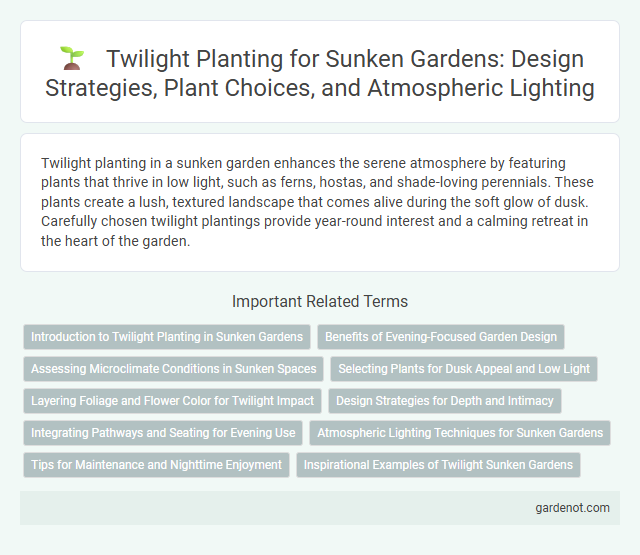Twilight planting in a sunken garden enhances the serene atmosphere by featuring plants that thrive in low light, such as ferns, hostas, and shade-loving perennials. These plants create a lush, textured landscape that comes alive during the soft glow of dusk. Carefully chosen twilight plantings provide year-round interest and a calming retreat in the heart of the garden.
Introduction to Twilight Planting in Sunken Gardens
Twilight planting in sunken gardens emphasizes the selection of shade-tolerant and dusk-blooming species such as ferns, impatiens, and evening primrose that thrive in low-light conditions. This horticultural technique maximizes the garden's aesthetic appeal during twilight hours by incorporating plants with luminescent foliage or fragrant blooms, enhancing sensory experiences. Strategic layering and color contrast optimize visual interest, creating a serene atmosphere that highlights the sunken garden's unique structural elements.
Benefits of Evening-Focused Garden Design
Twilight planting enhances the Sunken Garden by selecting flora that bloom or release fragrance during evening hours, creating a serene and visually appealing nighttime environment. These plants attract nocturnal pollinators like moths and bats, supporting local biodiversity and ecological balance. Incorporating glow-in-the-dark foliage and soft lighting further elevates safety and ambiance, promoting relaxation and extended garden use after sunset.
Assessing Microclimate Conditions in Sunken Spaces
Twilight planting in sunken gardens requires careful assessment of microclimate conditions, such as reduced sunlight exposure and cooler temperatures due to the garden's depth and surrounding walls. Understanding variations in humidity, wind patterns, and soil moisture is essential for selecting shade-tolerant and moisture-loving plants that thrive in low-light environments. Accurate microclimate analysis enhances plant health and aesthetic appeal, ensuring successful growth during dusk and evening hours.
Selecting Plants for Dusk Appeal and Low Light
Choosing twilight planting for a sunken garden involves selecting plants that thrive in low light and offer vibrant colors or interesting textures at dusk. Varieties such as ferns, hostas, and shade-tolerant hydrangeas provide lush greenery, while plants like physostegia and hellebores add subtle blooms that glow under fading light. Incorporating foliage with variegated leaves or silver tones enhances visual appeal, ensuring the garden remains captivating as daylight fades.
Layering Foliage and Flower Color for Twilight Impact
Layering foliage and flower colors in a Sunken Garden creates a striking twilight display that enhances depth and visual interest. Combining plants with contrasting textures, such as soft ferns with bold-leafed hostas, alongside vibrant blooms like purple salvias and orange dahlias, amplifies color transitions in fading light. Strategic placement of reflective foliage and late-blooming flowers intensifies the garden's twilight impact, making it a captivating focal point as daylight dims.
Design Strategies for Depth and Intimacy
Twilight planting in sunken gardens enhances depth and intimacy by utilizing layered foliage with varying heights and textures, creating a dynamic visual experience as daylight fades. Strategic placement of low-growing evergreens and shadow-casting tall plants frames pathways and seating areas, fostering a cozy, secluded ambiance. Incorporating subtle lighting among plants accentuates color contrasts and structural details, intensifying the garden's dimensionality and inviting quiet reflection.
Integrating Pathways and Seating for Evening Use
Twilight planting in sunken gardens enhances pathways with low-level, solar-powered lighting and scented night-blooming flowers, creating a tranquil ambiance for evening strolls. Incorporating curved, ergonomic seating made from weather-resistant materials encourages relaxation and social interaction after dusk. Strategically placed benches near illuminated beds maximize both comfort and the visual appeal during nighttime visits.
Atmospheric Lighting Techniques for Sunken Gardens
Twilight planting in sunken gardens enhances ambiance through carefully designed atmospheric lighting techniques such as low-voltage LED spotlights and recessed uplights strategically positioned to accentuate plant textures and architectural features. Soft, warm-hued lighting paired with reflective water elements creates a tranquil, immersive environment that highlights seasonal blooms and foliage during dusk hours. Incorporating adjustable dimmers and color temperature controls allows for tailored illumination, fostering dynamic visual interest and extending the enjoyment of the garden well into the evening.
Tips for Maintenance and Nighttime Enjoyment
Twilight planting in sunken gardens requires selecting low-maintenance, shade-tolerant plants like ferns, hostas, and impatiens that thrive in low light conditions. Watering early in the day prevents fungal diseases, while regular pruning ensures healthy growth and vibrant blooms. Strategically placed solar or LED lights enhance nighttime enjoyment by highlighting plant textures and garden pathways, creating a serene and inviting atmosphere after dusk.
Inspirational Examples of Twilight Sunken Gardens
Twilight planting in sunken gardens creates captivating spaces by combining low light-tolerant plants such as hostas, ferns, and heucheras that thrive in shaded environments. Inspirational examples include the Portland Japanese Garden, where delicate twilight hues and layered foliage enhance serene moods, and the Chicago Botanic Garden's Claire du Pont Sunken Garden, which uses twilight blooms like hydrangeas and astilbes to evoke a tranquil atmosphere. These designs emphasize texture, color contrast, and seasonal interest to maximize visual appeal during dusk hours.
Twilight planting Infographic

 gardenot.com
gardenot.com